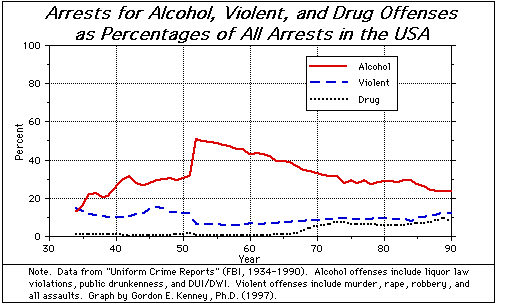 Sign the Resolution for a Federal
Commission on Drug Policy
Sign the Resolution for a Federal
Commission on Drug Policy Sign the Resolution for a Federal
Commission on Drug Policy
Sign the Resolution for a Federal
Commission on Drug Policy
Contents | Feedback | Search | DRCNet Home Page | Join DRCNet
DRCNet Library | Schaffer Library

Graph by Gordon E. Kenney, Ph.D. Licensed Psychologist Atlanta, Georgia, USA
The above graph presents trends in arrests for alcohol, violent, and drug offenses as percentages of all arrests in the USA according to the "Uniform Crime Reports" (FBI, 1934-1990). Clearly, alcohol offenses, which exceeded 50% of all arrests in the early 1950s, have consistently outpaced either violent and drug offenses since the mid-1930s, and continue to do so. Violent offenses, as a percentage of all arrests, have remained fairly steady with only slight increases after a period of relatively higher violence during the 1930s and 1940s. Arrests for drug offenses were barely detectable until the "get tough" policies of the Federal government began to take their toll in the late 1960s, yet drug arrests have never represented more than 10% of all arrests.
>From the data presented in the graph above, an objective observer would be hard-pressed not to conclude that alcohol is the substance which preoccupies law enforcement more than any other substance. Based on these 56-year trends, a law enforcement officer is 10 to 50 times more likely to encounter an alcohol offender than a drug offender, and is up to 7 times more likely to encounter an alcohol offender than a violent offender.
This despite the increasingly rabid demands by some for the death penalty for drug trafficking and longer sentences and increased fines for drug possession (often exceeding those for violent crimes). It seems that the "drug menace" is a created problem -- "make work" for bureaucratic paramilitary types, perhaps. The data from this graph as well as other independent and government sources simply do not indicate FROM AN OBJECTIVE STANDPOINT that there is a major drug problem. Any problems with drugs tend to be individualized and isolated phenomena.
Contents | Feedback | Search | DRCNet Home Page | Join DRCNet